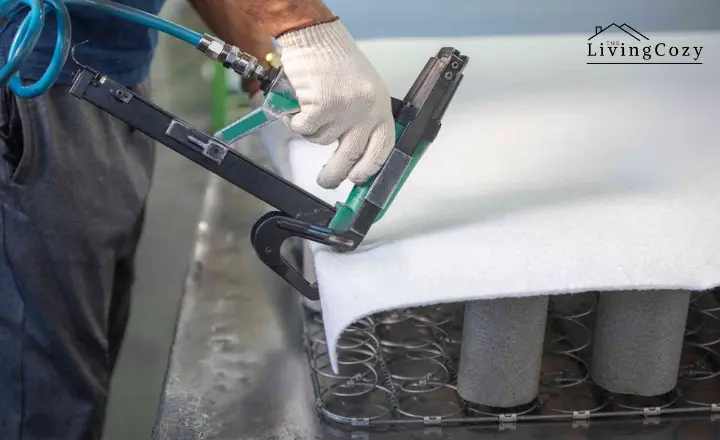To fix couch springs, you can start by identifying the broken or sagging springs and removing them from the couch. Measure and purchase replacement springs that match the size and type of the original ones. Once you have the new springs, carefully attach them to the frame of the couch using appropriate tools such as pliers or a staple gun. Test the repaired area by sitting on it to ensure that the springs are properly supporting the cushions.
Broken springs are the main cause of couch spring deterioration so we will fix them together.
Signs of Broken Springs:
- Squeaking or creaking noises when sitting or moving on the couch.
- Uneven or lumpy cushions that do not provide consistent support.
- Visible sagging or dipping in the seating area, especially in the middle of the couch.
- The feeling of sharp metal poking through the fabric when sitting down.
- Difficulty in getting up from the couch due to lack of spring support.
If you notice any of these signs, it’s likely that the springs in your couch are broken and may need to be couch repaired.
Identify Which Springs Are Broken:
Determine whether the type of springs in your couch are serpentine or sinuous. Serpentine springs are easier to fix than curved ones, which may require replacement due to their recoil.
Normal wear and tear can cause springs to snap or bend, so inspect them carefully to identify any damage. Once you’ve identified the broken springs, consider seeking professional help for an accurate and lasting solution.
Identifying broken springs in your couch involves understanding the type of springs present and assessing the extent of damage caused by normal wear and tear.
While fixing serpentine springs is relatively easier, sinuous springs may require replacement due to their recoil. Proper identification ensures effective repair and maintenance of your couch’s springs.
Couch Spring Repair Tools:

You will need a few essential tools and materials to repair couch springs.
Make sure to have a screwdriver, fabric glue, pliers, wooden slats, staple guns, replacement couch springs, and thick wire.
- The screwdriver will help disassemble the couch,
- The fabric glue can secure any loose upholstery.
- Pliers are necessary for bending and shaping the replacement springs and wire.
- Wooden slats support the new springs,
- A staple gun is essential for securing them in place.
- Ensure replacement couch springs and thick wire are ready for installation.
Readily available tools and materials will enable you to repair your couch springs efficiently without unnecessary delays or trips to the hardware store. With these items, you’ll be well-prepared to repair your couch springs effectively and with minimal hassle.
How to Fix Couch Springs?
Fixing couch springs can be a bit of a DIY adventure, but it’s doable with the right tools and a little caution. You must remove any staples or make an incision to access the springs. Once you’ve got them in sight, use pliers to straighten out any twisted or misaligned springs, but handle them carefully to avoid injury.
If the springs are beyond repair, you may need replacement ones. When it comes time to install them, grab some screws, a screwdriver, and those trusty pliers again.
Follow the manufacturer’s instructions closely to keep yourself safe and sound. With patience and attention to detail, your couch will be back in tip-top shape.
Tips For Maintaining Couch Springs:

Here are some tips for maintaining couch springs:
- Rotate and flip the cushions regularly to distribute the wear and tear evenly across the springs.
- Avoid jumping or standing on the couch, as this can put excessive pressure on the springs and cause them to wear out faster.
- Use a vacuum with an upholstery attachment to remove debris and dust from the springs and cushions.
- Consider adding additional support, such as plywood or a spring replacement kit, if you notice sagging or unevenness in the cushions.
- If you notice any broken or damaged springs, consider contacting a professional upholsterer to couch repair or replace them.
- Lastly, clean the couch regularly.
By following these tips, you can help prolong the life of your couch springs and keep your furniture in good condition for years to come.
Final Words:
Fixing couch springs is a manageable DIY task that can save you money and extend the life of your furniture. Following the steps outlined in this article (how to fix couch springs), you can identify and address issues with your couch springs, restoring comfort and support to your seating.
Remember to take proper safety precautions and seek professional help if necessary. With patience and attention to detail, you can successfully repair your couch springs and enjoy your furniture for years.
FAQ’s:
Can You Fix Broken Sofa Springs?
Yes, you can fix broken sofa springs. You can replace the spring with a new one if the spring is broken.
What kind of Springs are in Couches?
In most couches, you’ll find no-sag sinuous wire spring systems. These are made up of S-shaped wires that are stretched across the frame to provide support and flexibility.


